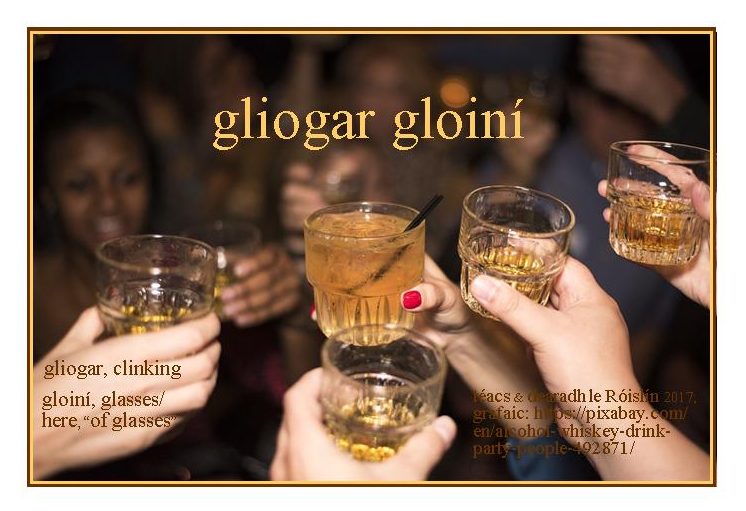Cén fhéile? Cén deoch? (An Irish Language Guide to Beverages and When to Drink Them) Part / Cuid 1 Posted by róislín on Mar 7, 2017 in Irish Language
(le Róislín)
While many beverages can readily be drunk all year around (piontaí Guinness ina measc), some are particularly associated with certain holidays or seasons. Today’s blogpost will start a mini-series about beverages and some special days they are most associated with. We’ll look at the beverages in seasonal order, starting with mí an Mhárta (in honor of “Lá Fhéile Pádraig“) and at the end of the series, we’ll do a little matching game as review.
Mí an Mhárta:
a)) Guinness, ar ndóigh, and here are a couple of sample phrases:
pionta Guinness, though I doubt one really has to add “Guinness” if you ask for a “pint” in Ireland.
dhá phionta Guinness, two pints of Guinness, with two points to remember: “dhá” causes “pionta” to change to “phionta” and, even more generally, nouns stay singular after numbers in Irish (remember, for example, “dhá mhadra” but “na madraí” and “deich mbosca” but “na boscaí“).
b)) beoir, beer a grammatically intriguing word, since it’s sometimes considered 5th-declension and sometimes considered irregular. At any rate, here are its main forms:
an bheoir, the beer
beorach, of beer (gloine beorach, canna beorach, buidéal beorach, srl.)
na beorach, of the beer (Fágann an leannlus rian ar bhlas na beorach)
na beoracha, the beers (Tá alt ag vinepair.com faoi na beoracha iompórtáilte is mó a bhfuil dúil ag daoine i Meiriceá iontu; nasc thíos, má tá suim agat ann)
na mbeoracha, of the beers (Is fearr liom blas na mbeoracha micreaghrúdaithe ná blas na mbeoracha atá grúdaithe go tionsclaíoch)
c)) An Pota Pádraig, which is basically “fuisce” (whiskey, aka “uisce beatha), but, at this time of year, there are references to drinking this from tumblers (!), i.e. full-sized “gloiní” as opposed to the more typical “gloine bhiotáille” (shot glass) or the linguistically intriguing “fiúigil” (also “shot glass). At any rate, the Pota Pádraig would also traditionally include the shamrock that one had worn during the day, and at the end of the drinking session, the “drowned” shamrock would be tossed over one’s shoulder for good luck.
Nóta gramadaí: So what’s the difference between a lower-case and lenited “pota Phádraig” and “An Pota Pádraig“? The phrase “pota Phádraig” (l.c.) would refer to a pot that someone named Pádraig happened to have or own. Presumably for cooking. With the phrase “An Pota Pádraig,” we have the exact opposite of the normal Irish structure. The first point of difference is that we’re including the definite article (“an“), which is normally not part of a possessive phrase using a person’s name in Irish (remember “cóta Cháit,” for example, which doesn’t use “an” before “cóta“). The second point is that “Pádraig,” when referring specifically to St. Patrick, is not normally lenited (i.e. no extra “h” is added). So, “An Pota Pádraig” for St. Patrick’s Day and “pota Phádraig” for your generic Patrick who likes to cook.
For a lot more “eolas” to accompany your “ólachán,” check out the link to Ireland’s Whiskey Museum below.
d)) caife Gaelach, one last entry for Lá Fhéile Pádraig. Certainly this can be drunk all year around but I’m sure it’s especially popular at this time of year. Céard iad na comhábhair (seachas an caife é féin): fuisce Éireannach, uachtar dúbailte nó uachtar coipthe, agus siúcra. Mmm, mín agus milis!
In case you’re wondering why the “caife” is “Gaelach” but the “fuisce” is “Éireannach,” the general guideline is that if it’s culturally Irish, it’s “Gaelach,” but if it’s Irish by birthright or place of manufacture, it’s “Éireannach.” But a lot of times I just find myself memorizing specific examples, which is sometimes easier than rationalizing them.
Mí Aibreáin
Well, the main day I can think of for this month, as far as beverages are concerned, would be Tartan Day (April 6), for which the “deoch” would be “uisce beatha Albanach” aka “fuisce na hAlban.” Presumably this is the “deoch an dorais” celebrated in song by Sir Harry Lauder and others. Just remember, if discussing the Scottish version of this golden nectar in English, it’s “whisky” (no “e”). But “a dhrop o’ the craythur,” that is the Irish version, in English would be “whiskey,” with the “e.” Both derive from one of the Celtic words for “water,” in the phrases uisce beatha (Irish) and uisge beatha (Scottish Gaelic), both meaning “water of life.” The River Usk in Wales, by the way, is a distant linguistic cousin, although the usual Welsh word for water is “dŵr,” which itself has a cousin in Irish, “dobhar” (as in “dobharchú” and “dobhareach“). Full circle!
Bhuel, that’s two months done, and I have a feeling that most of the other holiday beverages will cluster around Christmas and New Year’s (like eggnog and champagne), but I’ll have my thinking cap on for a few other seasonal examples in between. Tae oighrithe Inis Fada do lá te samhraidh, mar shampla? Suggestions welcome! And, although it’s not exactly an Irish expression, it can always be an excuse for a bit more vocab — Here’s “láib” in “do shúil.” – SGF – – Róislín
Naisc:
http://vinepair.com/wine-blog/20-most-popular-imported-beers-in-america/
http://www.irishwhiskeymuseum.ie/

Build vocabulary, practice pronunciation, and more with Transparent Language Online. Available anytime, anywhere, on any device.





Leave a comment: